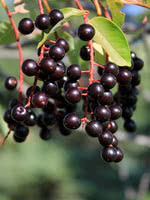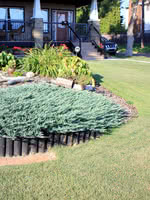Mon-Fri 9am - 5pm Mountain time
Western Chokecherry vs Creeping Juniper
Prunus virginiana var. demissa
Juniperus horizontalis
NOT AVAILABLE THIS SEASON - MIGHT RETURN
Western Chokecherry is a shrub or small tree commonly used for farmstead and field windbreaks.
It produces white flowers in the spring and edible dark purple fruit that matures between September and October. Its cherries are great for making for making jams, jellies or wine, but are not very palatable for raw eating.
Creeping Juniper is a low maintenance, spreading, ground cover shrub capable of growing in some of the worst soil and rocky conditions.
You will love this shrubs' pleasant fragrance and year-round color. A beautiful accent or foundation plant, Creeping Juniper has scaly foliage and is commonly used by landscapers to add texture under trees or flower beds. Consider planting Creeping Juniper in areas where grass is difficult to mow or maintain.
Western Chokecherry Quick Facts
Creeping Juniper Quick Facts
Toxicity: toxic to horses, cattle, etc.)

